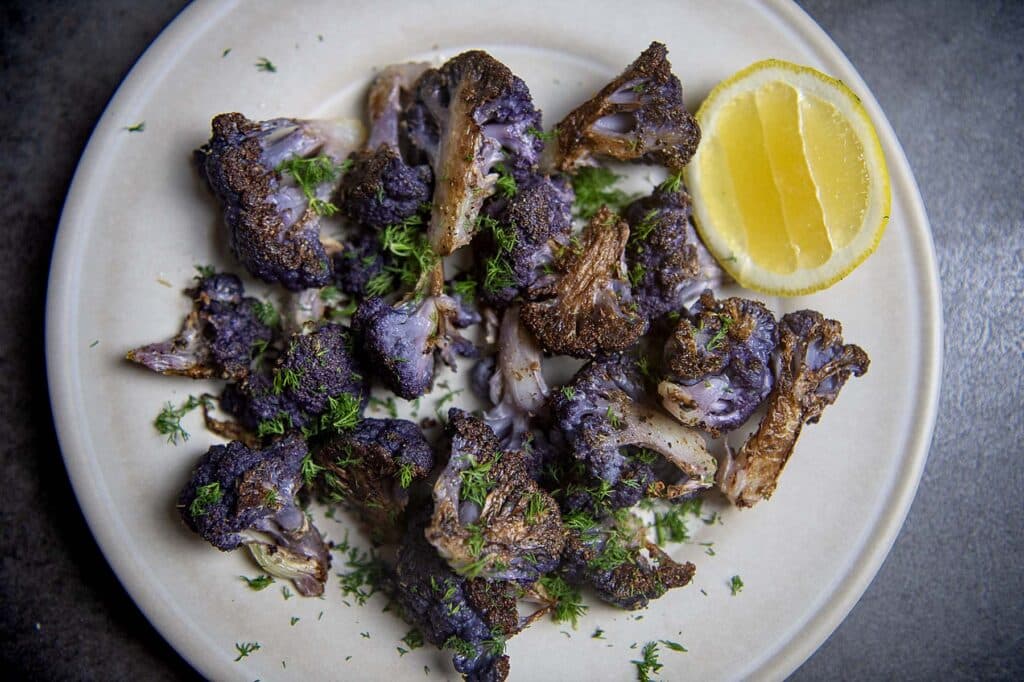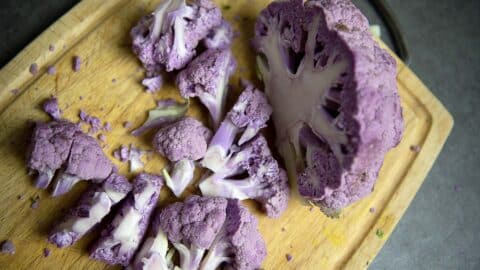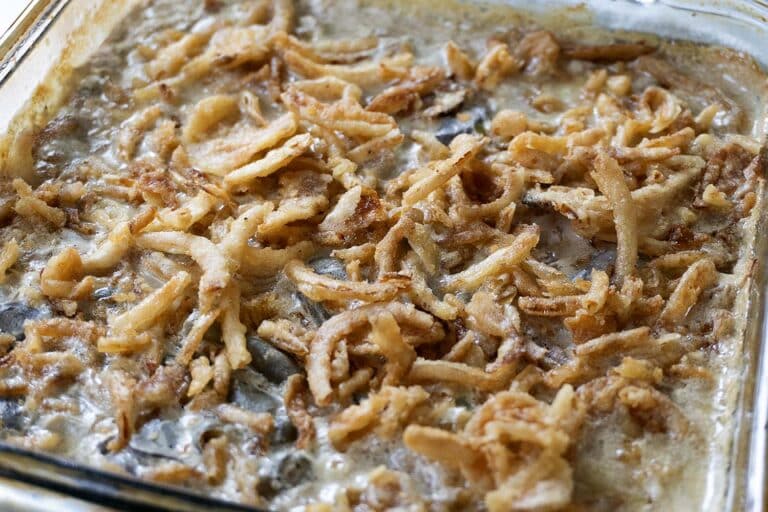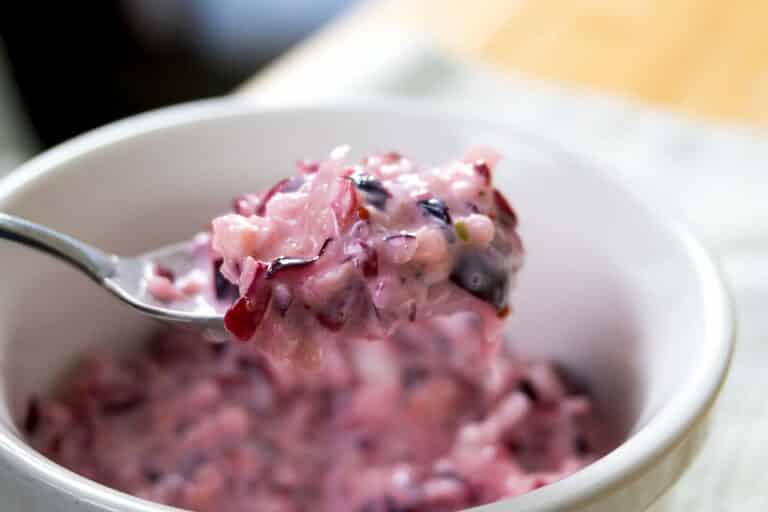Purple Cauliflower Recipe
If you’re into roasted vegetables, then this purple cauliflower recipe is for you! Not only is it easy, and delicious, but it’s great for anyone that LOVES vegetables.

How To Cook Purple Cauliflower?
Purple cauliflower is cooked in many of the same ways as white cauliflower, such as boiling, roasting, grilling, or sautéing. Here is a simple recipe for roasted purple cauliflower:
Ingredients:
- 1 head of purple cauliflower
- 2 tablespoons olive oil
- Salt and pepper to taste
- Optional: garlic powder, onion powder, or other seasonings of your choice
Instructions:
- Preheat your oven to 400°F (200°C).
- Cut the cauliflower into small florets and place them in a large mixing bowl.
- Drizzle the olive oil over the cauliflower and toss to coat evenly.
- Season with salt, pepper, and any other seasonings of your choice.
- Spread the cauliflower out in a single layer on a baking sheet.
- Roast in the preheated oven for 20-25 minutes, or until the cauliflower is tender and lightly browned.
- Remove from the oven and let cool for a few minutes before serving.
- Optional additional seasoning: garlic powder, onion powder, oregano, dried parsley
- For garnish:
- Fresh dill or parsley
- Squeeze of lemon
- For garnish:
Roasting brings out the natural sweetness of the purple cauliflower and enhances its rich color. You can also experiment with other cooking methods and seasonings to find your favorite way to enjoy this nutritious and flavorful vegetable.
What Is The Origin Of Purple Cauliflower?
Purple cauliflower is a natural variation of the traditional white cauliflower, and its origins are traced to the Mediterranean region of Europe.
The first known record of purple cauliflower dates back to the 16th century, when it was grown in the area that is now present-day Cyprus.

Over time, purple cauliflower spread throughout Europe, eventually making its way to the United States.
Purple cauliflower is a result of a genetic mutation that causes the production of anthocyanins, which are natural pigments that give the vegetable its rich purple color.
The mutation is rare, which is why purple cauliflower is not as widely available as its white counterpart.
However, with its unique color, delicious flavor, and numerous health benefits, purple cauliflower is gaining in popularity and becoming more widely available in markets and supermarkets.
Why Is My Cauliflower Purple?
Purple cauliflower is a variation of the traditional white cauliflower, and its purple color comes from the presence of anthocyanins, which are natural pigments found in many fruits and vegetables.

Anthocyanins are a type of flavonoid, a group of plant-based compounds that have antioxidant properties and are known to have numerous health benefits. In the case of purple cauliflower, the anthocyanins are responsible for the rich purple color, which can range from light lavender to deep purple.
Purple cauliflower is also rich in other nutrients, including vitamin C, vitamin K, folate, and fiber, making it a healthy addition to any diet.
If you purchased white cauliflower and it turned purple, it could be due to exposure to light or damage to the plant during growth or transport. However, if you intentionally bought purple cauliflower, then it is just a natural variation of the plant, and the purple color is completely normal and safe to eat.

Purple Cauliflower Nutrition?
It is a highly nutritious vegetable that is rich in a variety of vitamins, minerals, and other beneficial compounds. Here are some of the key nutrients found in purple cauliflower:
- Anthocyanins: Purple cauliflower contains high levels of anthocyanins, which are natural pigments that give the vegetable its rich purple color. Anthocyanins are also powerful antioxidants that have been linked to a range of health benefits, including reduced inflammation and improved heart health.
- Fiber: Purple cauliflower is a good source of fiber, which is important for digestive health and can help lower cholesterol levels.
- Vitamin C: One cup of cooked purple cauliflower contains about 40% of the recommended daily intake of vitamin C, which is important for immune system function and skin health.
- Vitamin K: Purple cauliflower is also a good source of vitamin K, which is essential for healthy bones and blood clotting.
- Folate: Purple cauliflower contains folate, a B vitamin that is important for brain and nervous system function, as well as healthy fetal development during pregnancy.
- Other nutrients: Purple cauliflower is also a good source of potassium, phosphorus, and vitamin B6.
Overall, purple cauliflower is a highly nutritious vegetable that can be a great addition to a healthy diet.

How To Tell If Cauliflower Is Bad?
There are a few ways to tell if cauliflower has gone bad:
- Appearance: Fresh cauliflower should have a clean, white or creamy color with tightly packed, firm florets. If the cauliflower has turned yellow, brown, or has any dark spots or mold, it is likely past its prime.
- Texture: The florets should be firm and tightly packed. If they are soft, mushy, or have a slimy texture, the cauliflower is no longer fresh and should be discarded.
- Smell: Fresh cauliflower has a mild, earthy aroma. If the cauliflower smells sour, pungent, or rotten, it is no longer fresh and should be discarded.
- Taste: If you taste a small piece of the cauliflower and it tastes bitter, sour, or unpleasant, it is likely past its prime.
It’s important to note that cauliflower can spoil quickly, especially if not stored properly. To keep cauliflower fresh for as long as possible, store it in a perforated plastic bag in the refrigerator, and use it within 3 to 5 days.
Is Cauliflower Man Made?
No, cauliflower is not man-made. It is a natural vegetable that has been cultivated by humans for thousands of years.
The wild ancestor of cauliflower is believed to be a plant called the wild mustard plant (Brassica oleracea), which grows along the Mediterranean coast.
Over time, humans selected and cultivated varieties of the wild mustard plant that produced larger and more tender flower buds, eventually leading to the development of cauliflower as we know it today.
While cauliflower is a result of human cultivation and selective breeding, it is not a genetically modified organism (GMO).
GMOs are created by inserting foreign genetic material into an organism’s DNA in a laboratory setting. Cauliflower and other plants have been selectively bred over time to create new varieties with desired traits, but their DNA has not been altered in a laboratory.
Where To Buy Purple Cauliflower?
Purple cauliflower is in many grocery stores and supermarkets, especially those that specialize in organic or specialty produce. Some popular places to look for purple cauliflower include:
- Farmers’ markets: Many farmers’ markets offer a wide variety of fresh and locally grown produce, including purple cauliflower.
- Health food stores: Health food stores often carry a variety of organic and specialty produce, including purple cauliflower.
- Supermarkets: Some large supermarkets may carry purple cauliflower in their produce section, especially those with a wide selection of fresh produce.
- Online retailers: Many online retailers specialize in delivering fresh produce directly to your doorstep. Check websites like FreshDirect, Farmbox Direct, and Imperfect Foods to see if they offer purple cauliflower.
When shopping for purple cauliflower, look for heads that are firm, with no brown spots or signs of mold. The color should be a rich, vibrant purple, with no signs of discoloration. With its unique color and delicious flavor, purple cauliflower is a fun and nutritious addition to any meal.
- 1 head purple cauliflower
- 2 tbsp extra virgin olive oil
- 1 teaspoon salt and pepper
- 1 optional garlic powder, onion powder, oregano, dried parsley dill and parsley, as well as lemon for garnish







